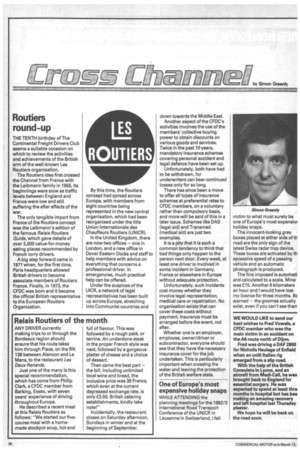Routiers round-up
Page 38

If you've noticed an error in this article please click here to report it so we can fix it.
THE TENTH birthday of The Continental Freight Drivers Club seems a suitable occasion on which to review the activities and achievements of the British arm of the well-known Les Routiers organisation.
The Routiers idea first crossed the Channel from France with the Leibmann family in 1955. Its beginnings were slow as traffic levels between England and France were low and still suffering the after effects of the war.
The only tangible import from France of the Routiers concept was the Leibmann's edition of the famous Relais Ratifiers Guide, which gave details of over 3,000 value-for-money eating places recommended by French lorry drivers.
A big step forward came in 1971 when, for the first time, Paris headquarters allowed British drivers to become associate members of Routiers France. Finally, in 1973, the CFDC was born and it became the official British representative to the European Routiers Organization. By this time, the Routiers concept had spread across Europe, with members from eight countries being represented in the new central organisation, which had been reorganised under the title Union Internationale des Chauffeurs Routiers (UNICR), In the United Kingdom, there are now two offices — one in London, and a new office in Dover Eastern Docks and staff to help members with advice on everything that concerns a professional driver. In emergencies, much practical help can be offered.
Under the auspices of the UICR, a network of legal representatives has been built up across Europe, stretching into Communist countries and down towards the Middle East.
Another aspect of the CFDCs activities involves the use of the members' collective buying power to obtain discounts on various goods and services. Twice in the past 10 years, mandatory insurance schemes covering personal accident and legal defence have been set up.
Unfortunately, both have had to be withdrawn, for underwriters can bear continued losses only for so long.
There has since been a move to offer all types of insurance schemes at preferential rates to CFDC members, on a voluntary rather than compulsory basis, and more will be said of this in a later issue. Schemes like DAS (legal aid) and Transmed (medical aid) are just two examples.
It is a pity that it is such a common tendency to think that bad things only happen to the person next door. Every week, at least one driver is involved in some incident in Germany, France or elsewhere in Europe without adequate protection.
Unfortunately, such incidents cost money whether they involve legal representation, medical care or repatriation. No organisation exists that can cover these costs without payment. Insurance must be arranged before the event, not after.
Whether one is an employer, employee, owner/driver or subcontractor, everyone should see that they have the necessary insurance cover for the job undertaken. This is particularly important when crossing the water and leaving the protection of the British welfare state. victim to what must surely be one of Europe's most expensivi holiday snaps.
The innocent-looking grey boxes placed at either side of th road are the only sign of the latest Swiss radar trap device. These boxes are activated by th excessive speed of a passing vehicle and an automatic photograph is produced.
The fine imposed is automati. and calculated to a scale. Mine was £15. Another 6 kilometers an hour and I would have lost my license for three months. Eif warned — the gnomes actually exist, even if you can't see therr




























































































